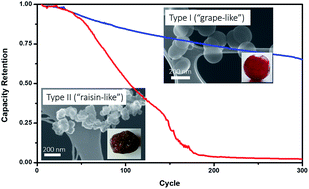Morphology engineering of silicon nanoparticles for better performance in Li-ion battery anodes†
Abstract
Amorphous silicon nanoparticles were synthesized through pyrolysis of silane gas at temperatures ranging from 575 to 675 °C. According to the used temperature and silane concentration, two distinct types of particles can be obtained: at 625 °C, spherical particles with smooth surface and a low degree of aggregation, but at a higher temperature (650 °C) and lower silane concentration, particles with extremely rough surfaces and high degree of aggregation are found. This demonstrates the importance of the synthesis temperature on the morphology of silicon particles. The two types of silicon nanoparticles were subsequently used as active materials in a lithium half cell configuration, using LiPF6 in an alkylcarbonate-based electrolyte, in order to investigate the impact of the particles morphology on the cycling performances of silicon anode material. The difference in morphology of the particles resulted in different volume expansions, which impacts the solid electrolyte interface (SEI) formation and, as a consequence, the lifetime of the electrode. Half-cells fabricated from spherical particles demonstrated almost 70% capacity retention for over 300 cycles, while the cells made from the rough, aggregated particles showed a sharp decrease in capacity after the 20th cycle. The cycling results underline the importance of Si particle engineering and its influence on the lifetime of Si-based materials.



 Please wait while we load your content...
Please wait while we load your content...